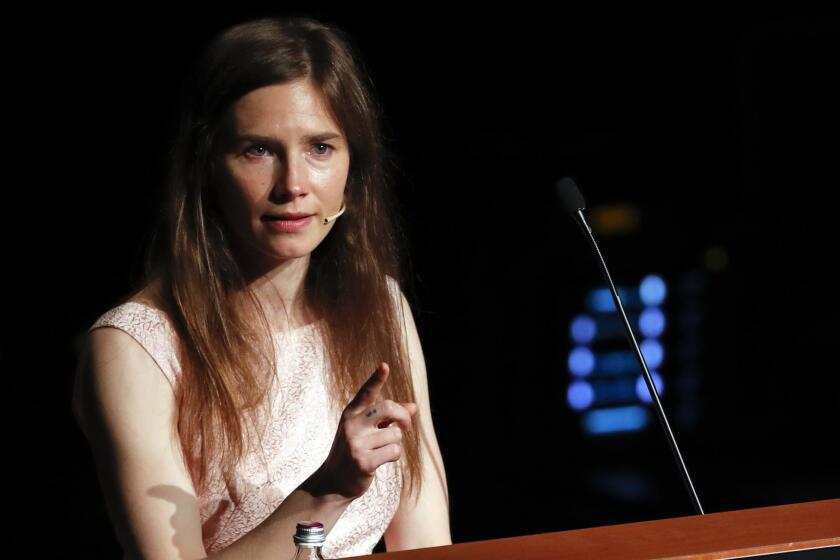Review: The CW’s ‘Frequency’ seizes on two top TV trends but ends up generic and hokey
- Share via
Throughout pop culture, people have transcended the barriers of time and space using all manner of conveyance: Souped-up DeLoreans. Police boxes. Hot tubs.
In “Frequency,” which arrives Wednesday on the CW, the unlikely magical object is a ham radio that allows NYPD Det. Raimy Sullivan (Peyton List) to communicate with her late father, Frank, also a cop (Riley Smith), in the year 1996. A gender-switched update on the 2000 film starring Dennis Quaid and Jim Caviezel, “Frequency” combines two of the biggest trends on TV at the moment: time travel and movie adaptations.
Created by Jeremy Carver (“Supernatural”), it is an unabashedly hokey affair with an inherently seductive premise. The problem is that “Frequency” is too generic to make the sentiment work.
The drama opens in the present day, on the morning of Raimy’s 28th birthday. The young homicide detective is called to investigate a skeleton uncovered in a nearby marsh and thought to belong to a victim of a serial killer active 20 years ago.
Though she’s followed in his professional footsteps and even works with his old partner (an underused Mekhi Phifer), Raimy is ashamed of Frank’s tarnished legacy. As she explains to her dreamy architect boyfriend Daniel (Daniel Bonjour), Frank was an undercover cop who became corrupted and wound up dead in the East River two days after her 8th birthday.
Or at least that’s the story she’s always been told. But it begins to unravel late one night when Frank’s old ham radio suddenly lights up for reasons that are never explained, though lightning is involved. The staticky voice emanating from the radio belongs to her father, speaking to her from the past — just two days before he’s due to be killed, in fact. After an investigation so cursory you wonder why it took her so long to do it, Raimy discovers that Frank was actually part of a secret sting operation gone awry and wasn’t a bad guy after all. Via the airwaves, she’s able to help Frank avert death.
But Frank’s survival creates a butterfly effect of unintended consequences, with profound implications for Raimy’s present-day life (without revealing too much, you can bet that serial killer comes into play). Presumably, the series will follow Frank and Raimy as they attempt to right the past without irrevocably altering the future, with different versions of their lives playing out from week to week. (I do not envy the script supervisor on this series.)
“Frequency” is a curious choice for a TV remake. It generated respectable-if-unspectacular box office and mixed reviews in 2000, but its central conceit seems too transparently goofy — really, a dead guy who speaks through a ham radio? — to sustain an entire series.
But the most urgent problem is that “Frequency” is based on source material that was already derivative, a grab bag of tropes borrowed from movies including “Back to the Future,” “Sliding Doors” and “Ghost.” Other than switching the gender of the lead, there’s been little effort to liven up the formula for television, and the characters lack the nuance or specificity that would make us feel invested in their fate.
It is also notably lacking local flavor and has the ersatz feel of a show produced in Canada (which it is). Beyond her character’s NYPD T-shirt and encyclopedic knowledge of the Mets, there’s little about List, best known for playing Roger Sterling’s spoiled second wife on “Mad Men,” that suggests outer-borough New York. As Frank, Smith at least attempts a New York accent, but he also seems more like, well, the lead of a CW drama than a hard-bitten, big-city detective
The relationship between Raimy and Frank, so essential to making the story work, also falls flat, in part because “Frequency” relies on vague flashback montages and bluntly expository dialogue to fill in their backstory. The fact that Frank and Raimy are also about the same age (albeit separated by two decades) makes it that much harder to buy them as father and daughter.
Perhaps in order to age down List’s role, the time difference in the series is shorter than in the film, in which the characters communicated across a 30-year divide. The decision leads to some awkward attempts to distinguish between the present day and ye olde times of 1996. At one point, Frank is baffled by Raimy’s use of the word “trolling,” and he tends to appear as songs by Live and Oasis play on the soundtrack, as if to remind us it’s the ’90s.
If only time travel were as easy as flipping on the radio.
See the most-read stories in Entertainment this hour »
‘Frequency’
Where: KTLA
When: 9 p.m. Wednesday
Rating: TV-PG-DLV (may be unsuitable for young children with advisories for suggestive dialogue, coarse language and violence)
Follow me @MeredithBlake
The complete guide to home viewing
Get Screen Gab for everything about the TV shows and streaming movies everyone’s talking about.
You may occasionally receive promotional content from the Los Angeles Times.



